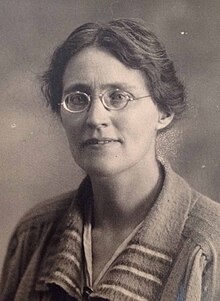Grace Mary Crowfoot | |
|---|---|
 | |
| Born | Grace Mary Hood 1879 Lincolnshire, England |
| Died | 1957 Geldeston, Norfolk |
| Other names | Molly |
| Occupation(s) | botanist and textile archaeologist |
| Notable work | From Cedar to Hyssop (1932, co-author) |
| Spouse | |
| Children | Four girls, incl. Dorothy and Joan |
| Relatives | Sinclair Hood (nephew) |
| Scientific career | |
| Fields | Archaeology, botany |
Grace Mary Crowfoot (née Hood; 1879–1957) was a British archaeologist and a pioneer in the study of archaeological textiles.[1] During a long and active life Molly—as she was always known to friends, family and close colleagues—worked on a wide variety of textiles from North Africa, the Middle East, Europe and the British Isles. Returning to England in the mid-1930s after more than three decades spent in Egypt, Sudan and Palestine, Crowfoot co-authored a 1942 article on the "Tunic of Tutankhamun" and published short reports about textiles from the nearby Anglo-Saxon ship burial at Sutton Hoo (1951-1952) in Suffolk.
Molly Crowfoot trained a generation of textile archaeologists in Britain, among them Audrey Henshall and her daughter Elisabeth,[2] and developed close contacts with textile archaeologists in Scandinavia such as Margrethe Hald, Marta Hoffman and Agnes Geijer. Together they established a new field of study, ensuring that textile remnants found at any site were henceforth preserved for analysis, instead of being cleaned from the metal and other objects to which they remained attached.[3] Much of Crowfoot's collection of textiles, spinning and weaving implements is now held at the Textile Research Centre in Leiden.[4]
Her eldest daughter Dorothy was a prominent chemist and crystallographer who won the Nobel Prize in Chemistry in 1964.[5] Her second daughter Joan was an archaeologist and worked for many years at the Ashmolean Museum in Oxford.
After her death obituaries were published by her son-in-law, the Africanist Thomas Hodgkin and by the archaeologist Kathleen Kenyon.
- ^ "Breaking Ground: Women in Old World Archaeology". www.brown.edu. Retrieved 2023-10-04.
- ^ "Elisabeth Grace Crowfoot", Encyclopaedia of Mediaeval Dress and Textiles, Brill: Leiden, 2012, pp. 158–161.
- ^ John R. Crowfoot (2012). "Crowfoot, Grace (1877-1957)". In Gale Owen-Crocker; Elizabeth Coatsworth; Maria Hayward (eds.). Encyclopedia of Medieval Dress and Textiles of the British Isles, c. 450–1450. Leiden: Brill / Textile Research Centre. pp. 161–164. ISBN 978-90-04-12435-6.
- ^ "The diversity of the TRC collection: Grace Crowfoot Collection". TRC. Retrieved August 8, 2019.
- ^ Matthew, H. C. G.; Harrison, B., eds. (2004-09-23). "The Oxford Dictionary of National Biography". Oxford Dictionary of National Biography (online ed.). Oxford University Press. pp. ref:odnb/55028. doi:10.1093/ref:odnb/55028. Retrieved 2019-12-01. (Subscription or UK public library membership required.)